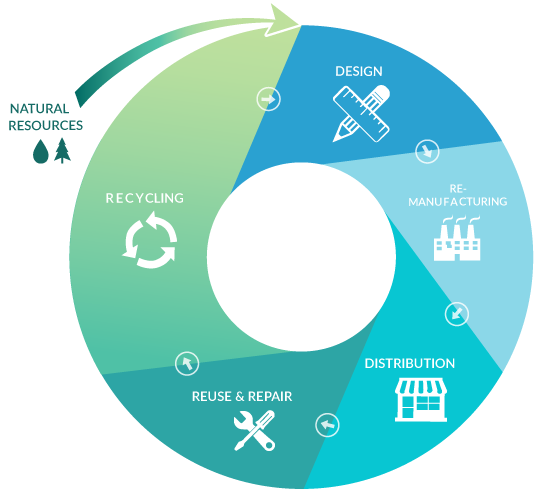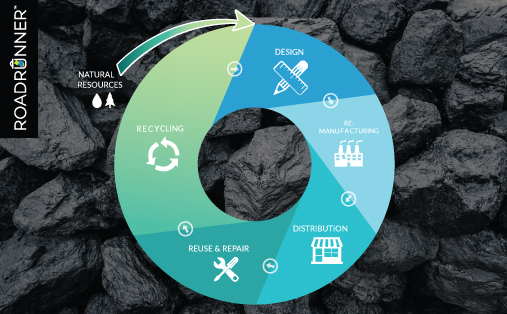FAST FACTS:
Before you dive into the main content in this post, check out these surprising facts:
- Humans extract billions of tons of natural resources from the Earth every year, which we will eventually run out of if we don't make a change.
- In 2017, we used a year's worth of the Earth's resources in only seven months.
- The total demand for natural resources is expected to reach 130 billion tons by 2050, up from 50 million in 2014.
Upon learning this information, we wanted to know how we got here, and what we need to do to help conserve our natural resources. For a long time, our economy has been linear, but in order to preserve natural resources and reduce the amount of waste we generate, our economy must become circular. In this post, we cover everything you need to know about why we need to transition away from a linear economy, why it's time to start thinking circular, and which brands are embracing the circular economy concept. Continue reading to learn more!
Why Is It Time To Start Thinking Circular?
We currently live in a society where everything is disposable, from plastic packaging, to clothing, to electronics and office furniture. Think about how often humans go through the cycle of throwing away goods as waste in exchange for new disposable goods. Our ecosystems can no longer keep up with the 'take, make, and waste' model, in which natural resources are extracted, turned into products, sold to consumers, and used until they are discarded as waste (see our diagram below). This approach is known as the linear economy and it has enabled companies to produce and sell more and more inexpensive products, but unfortunately, it is not sustainable at all. According to a New York Post article, Mathis Wackernagel, the head of Earth Overshoot Day, explains that in 2017 we used a year's worth of the Earth's resources in only seven months. “We are using the Earth’s future resources to operate in the present and digging ourselves deeper into ecological debt," said Wackernagel.

If we continue down this path, the total demand for resources is expected to reach 130 billion tons by 2050, up from 50 million in 2014. Transitioning towards a circular economy is an opportunity to benefit our society and the environment. The following three principles are the foundation of the circular model:
1. Design out waste and pollution
2. Keep products and materials in use
3. Regenerate natural systems
Built around these principles, the circular method redefines how products are designed, manufactured, distributed, repaired/reused, and recycled. The end goal is to minimize our dependence on natural resources, prolong and extend the life of raw materials, and reduce waste.

how do we shift to a circular economy?
Hopefully by now we can all agree that a circular economy is the more sustainable option, but how do we make the switch from a linear economy? By rethinking how we produce and use products, businesses and consumers can help regenerate our natural resources and reduce waste. For this concept to work, all stakeholders of the product cycle must take responsibility, from the product designers and manufacturers, to distributors, to end users (consumers). Let's take a look at how the circular economy works and how following this method keeps products in use:
DESIGN
Design is critical when it comes to the circular economy. Manufacturers must design products and packaging for durability, reuse/repair, using materials that are easily recyclable at the end of the product's life. This supports the goal of raw material circulation in the economy and keeps products in use for as long as possible.
![]()
re-manufacturing
During production and manufacturing, businesses must focus on redesigning processes, products, and services to reduce natural resources, greenhouse gas production, and fossil fuel utilization. Many manufacturers are doing this by using materials such as bamboo or compostable packaging as a substitute for plastic packaging.
DISTRIBUTION
Retailers need to provide customers with education and awareness about their products, including information about end-of-life take-back services, repair services, and trade-ins. Many retailers like Best Buy or Staples offer trade-in programs for electronics, who will then recycle them so they do not end up in landfills.
![]()
REUSE & REPAIR
Many companies are working with consumers to help them reduce waste by providing the tools to help them maximize the life of their products, including reuse and repair services. To keep the items around longer, some retailers have launched programs such as jean repair services, shoe collections, or educational videos to help inform customers on how to repair their products at home.
RECYCLing
Recycling will lead to fewer materials ending up in landfills, which ultimately means less extraction of natural resources. To make sure materials are responsibly recycled, all stakeholders must prioritize recycling. Examples of recycling prioritization include recycling service providers offering efficient collection services for businesses, retailers providing recycling services or collection programs in their stores, and consumers buying-in to proper disposal of their materials.
BUSINESSES EMBRACING THE CIRCULAR ECONOMY CONCEPT
MUD JEANS creates 'LEASE-A-JEANS'
In 2013, Mud Jeans introduced their 'Lease A Jeans' concept, which allows consumers to rent or switch out their jeans whenever they want a new pair. This concept enables Mud Jeans to have ownership of the jeans so that they can properly recycle or refurbish them. Over the past three years, Mud Jeans saved 12,000 jeans from landfill and incineration and turned them into new denim.

ADIDAS X PARLEY FOR THE OCEANS
Adidas has teamed up with Parley for the Oceans (an environmental organization) to make athletic shoes made exclusively from plastic collected from our oceans. Adidas recently announced they have committed to using only recycled plastics in all of their products by 2024. “When you wear out this product, you give it back to us. And we recycle it,” says Tanyaradzwa Sahanga, a materials engineer at Adidas.
Closing the (circular) loop
What do you think about the circular economy concept? Let us know by leaving us a note in the comment section below. If you are interested in learning how RoadRunner can help your business recycle, schedule a free consultation with us today. Thanks for reading!

